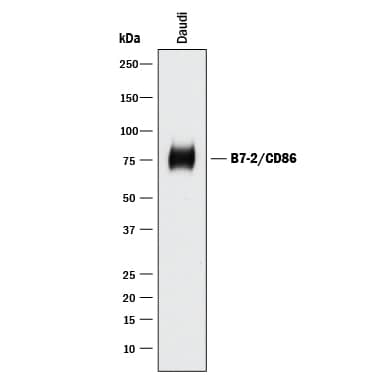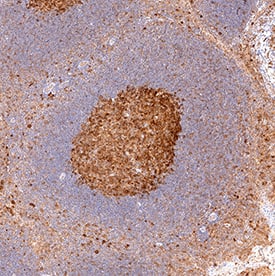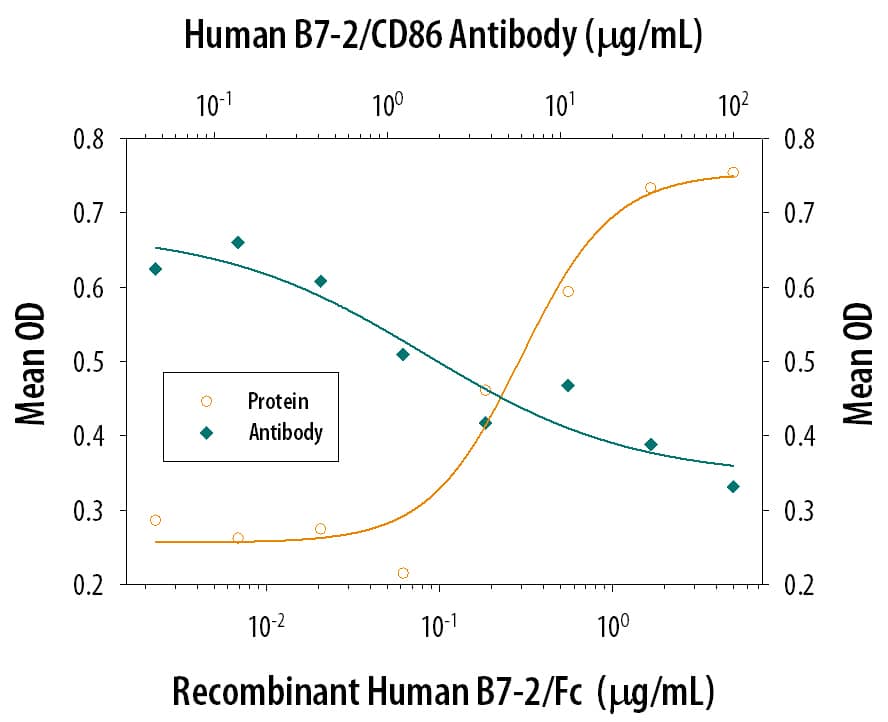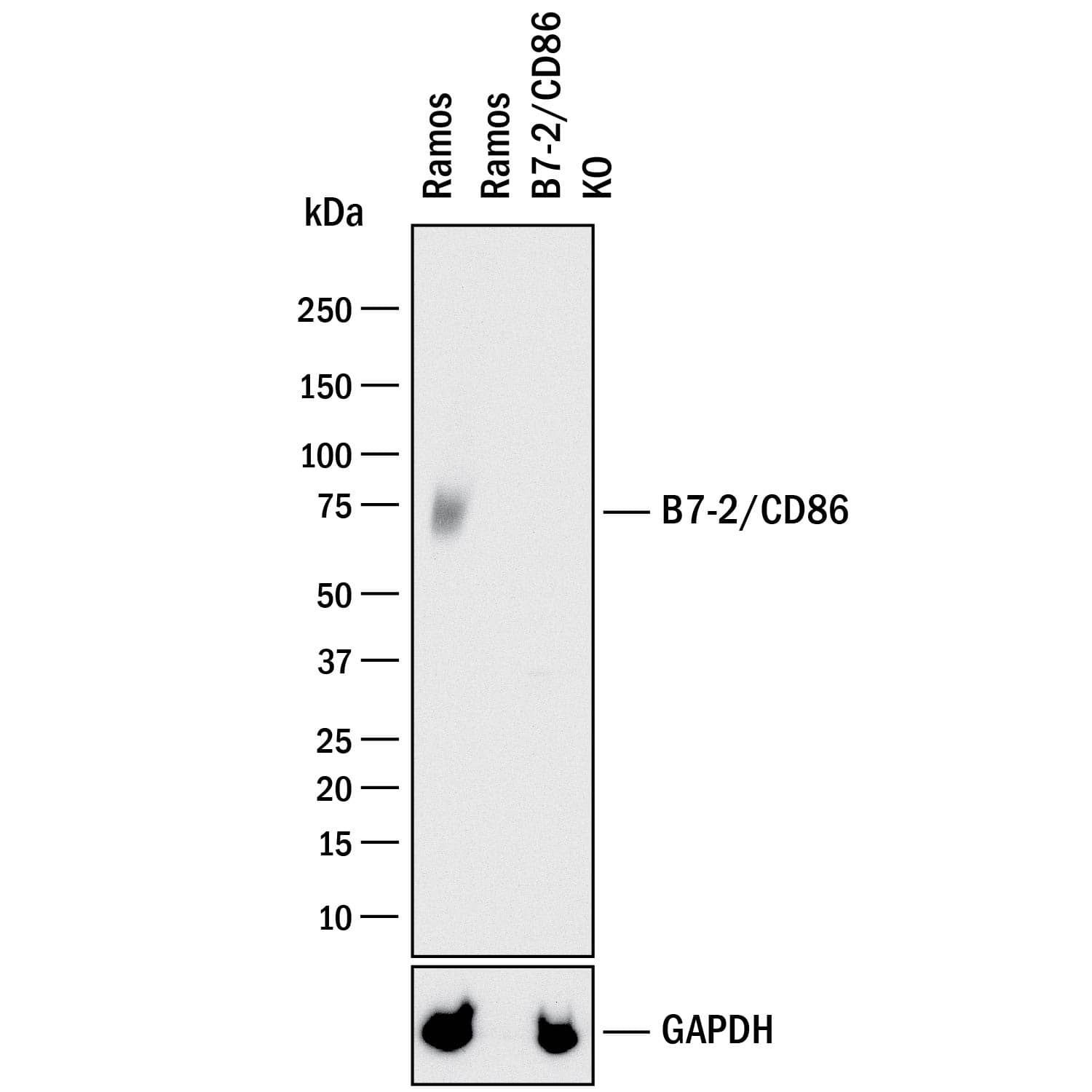Human B7-2/CD86 Antibody
R&D Systems, part of Bio-Techne | Catalog # AF-141-NA


Key Product Details
Validated by
Species Reactivity
Validated:
Cited:
Applications
Validated:
Cited:
Label
Antibody Source
Product Specifications
Immunogen
Ala23-His244
Accession # P42081
Specificity
Clonality
Host
Isotype
Endotoxin Level
Scientific Data Images for Human B7-2/CD86 Antibody
Detection of Human B7‑2/CD86 by Western Blot.
Western blot shows lysates of Daudi human Burkitt's lymphoma cell line. PVDF membrane was probed with 0.5 µg/mL of Goat Anti-Human B7-2/CD86 Antigen Affinity-purified Polyclonal Antibody (Catalog # AF-141-NA) followed by HRP-conjugated Anti-Goat IgG Secondary Antibody (Catalog # HAF017). A specific band was detected for B7-2/CD86 at approximately 75 kDa (as indicated). This experiment was conducted under reducing conditions and using Immunoblot Buffer Group 1.B7‑2/CD86 in Human Tonsil.
B7-2/CD86 was detected in immersion fixed paraffin-embedded sections of human tonsil using Goat Anti-Human B7-2/CD86 Antigen Affinity-purified Polyclonal Antibody (Catalog # AF-141-NA) at 15 µg/mL overnight at 4 °C. Tissue was stained using the Anti-Goat HRP-DAB Cell & Tissue Staining Kit (brown; Catalog # CTS008) and counterstained with hematoxylin (blue). View our protocol for Chromogenic IHC Staining of immersion fixed paraffin-embedded Tissue Sections.B7‑2/CD86 in Human Tonsil.
B7-2/CD86 was detected in immersion fixed paraffin-embedded sections of human tonsil using Goat Anti-Human B7-2/CD86 Antigen Affinity-purified Polyclonal Antibody (Catalog # AF-141-NA) at 3 µg/mL for 1 hour at room temperature followed by incubation with the Anti-Goat IgG VisUCyte™ HRP Polymer Antibody (Catalog # VC004). Tissue was stained using DAB (brown) and counterstained with hematoxylin (blue). Specific staining was localized to lymphocytes. View our protocol for IHC Staining with VisUCyte HRP Polymer Detection Reagents.Applications for Human B7-2/CD86 Antibody
Immunohistochemistry
Sample: Immersion fixed paraffin-embedded sections of human tonsil
Knockout Validated
Western Blot
Sample: Daudi human Burkitt's lymphoma cell line
Neutralization
Reviewed Applications
Read 1 review rated 3 using AF-141-NA in the following applications:
Formulation, Preparation, and Storage
Purification
Reconstitution
Formulation
Shipping
Stability & Storage
- 12 months from date of receipt, -20 to -70 °C as supplied.
- 1 month, 2 to 8 °C under sterile conditions after reconstitution.
- 6 months, -20 to -70 °C under sterile conditions after reconstitution.
Background: B7-2/CD86
B7-1 and B7-2, together with their receptors CD28 and CTLA-4, constitute one of the dominant costimulatory pathways that regulate T- and B-cell responses. Although both CTLA-4 and CD28 can bind to the same ligands, CTLA-4 binds to B7-1 and B7-2 with a 20‑100 fold higher affinity than CD28 and is involved in the down‑regulation of the immune response. B7-1 is expressed on activated B cells, activated T cells, and macrophages. B7-2 is constitutively expressed on interdigitating dendritic cells, Langerhans cells, peripheral blood dendritic cells, memory B cells, and germinal center B cells. Additionally, B7-2 is expressed at low levels on monocytes and can be up-regulated through interferon gamma. B7-1 and B7-2 are both members of the immunoglobulin superfamily. Human B7-2 is a 329 amino acid (aa) protein containing a putative 23 aa signal peptide, a 224 aa extracellular domain, a 21 aa transmembrane domain, and a 61 aa cytoplasmic domain. Human B7-2 and B7-1 share 26% amino acid identity. Human and mouse B7-2 share 50% amino acid identity. However, it has been observed that both human and mouse B7‑1 and
B7‑2 can bind to either human or mouse CD28 and CTLA-4, suggesting that there are conserved amino acids which form the B7-1/B7-2/CD28/CTLA-4 critical binding sites.
References
- Azuma, M. et al. (1993) Nature 366:76.
- Freeman, G.J. et al. (1993) Science 262:909.
- Freeman, G. et al. (1991) J. Exp. Med. 174:625.
- Selvakumar, A. et al. (1993) Immunogenetics 38:292.
- Chen, C. et al. (1994) J. Immunol. 152:4929.
- Freeman, G.J. et al. (1993) J. Exp. Med. 178:2185.
Alternate Names
Gene Symbol
UniProt
Additional B7-2/CD86 Products
Product Documents for Human B7-2/CD86 Antibody
Product Specific Notices for Human B7-2/CD86 Antibody
For research use only



